Photos: How Dutch Painter Rembrandt Created His Famous Self-Portraits
Portrait of a man
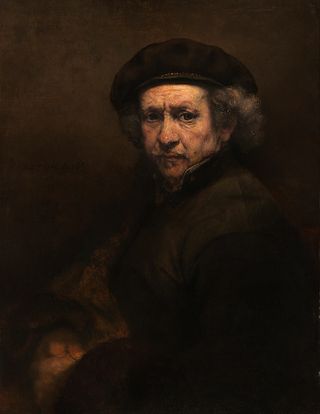
Two researchers in Britain have revived a debate about the 17th-century Dutch artist Rembrandt Harmenszoon van Rijn, with a new study that suggests the Old Master created his famously lifelike self-portraits by tracing them from an optical projection of himself.
Rembrandt made nearly 100 self-portraits from the 1620s until his death in 1669, including around 50 paintings as well as dozens of etchings and drawings. This Rembrandt self-portrait in oil on canvas from 1659 is nearly life-size, and the researchers think it was painted from an optical projection created by a specific arrangement of a curved mirror and a flat mirror.
Projecting an image
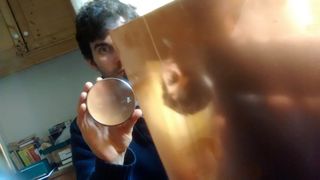
The new research by artist and optics researcher Francis O'Neill — seen here with an image of his face projected through two mirrors onto a copper plate — and physicist Sofia Palazzo Corner was published in the Journal of Optics.
The research includes a detailed analysis of the combinations of flat and curved mirrors, or flat mirrors and lenses, which can be used to replicate the proportions, perspectives and lighting seen in Rembrandt's self-portraits.
Mirror, mirror
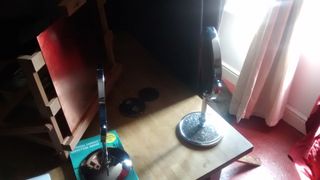
O'Neill began the research in his studio with curved and flat mirrors that he bought at a pharmacy, under natural light with aluminum foil as a projection surface.
As his experiments proceeded, he used larger mirrors to obtain a larger image and a copper etching plate as a brighter projection surface, shown in this image.
Clear projections
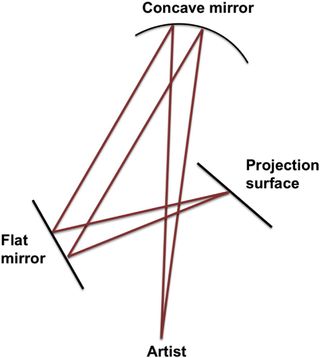
This diagram shows the set-up for life-size self-portrait projections using a curved and a flat mirror. The researchers were able to achieve a clear, life-size projection using a concave mirror measuring 4 inches (10 centimeters) across, with a focal length of 40 inches (100 centimeters) and the artist standing a distance of twice the focal length.
A second flat mirror combined with a refracting lens can be used in place of the concave mirror.
Self-portraits
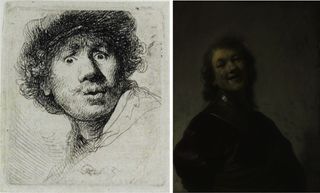
For smaller than life-size self-portraits like these, the researchers think Rembrandt used narrower, longer arrangements of flat and moderately curved mirrors to project a smaller image. The etching at the left, dubbed "Self Portrait with wide open eyes," was made in 1630 and measures about 2 inches by 1.8 inches (5 centimeters by 4.5 centimeters).
At right, "Rembrandt laughing" is a self-portrait painted in oil on copper in 1628 and measures 8.7 by 6.7 inches (22 cm by 17 cm).
The researchers were able to make clear projections of similar sizes with concave mirrors of focal lengths between 5.5 and 9.8 inches (14 and 25 cm).
Camera obscura
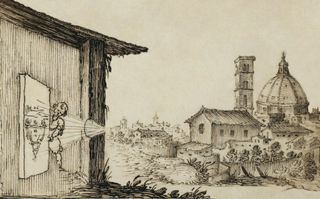
The new research follows work published by British artist David Hockney and American physicist Charles Falco in 2001 that proposed that many leading Renaissance and early modern European artists, including Rembrandt and Leonardo Da Vinci, often used optical equipment such as mirrors and lenses to create some of their most famous works of art.
In the early 16th century, for example, Da Vinci wrote about the use of the camera obscura, a primitive type of camera that uses a hole in the wall of a darkened room as a lens to create an upside-down projection.
The reversed image, created by a camera obscura, is shown in this illustration from a 17th-century manual on military arts, which included geometry and mechanics.
Dutch master
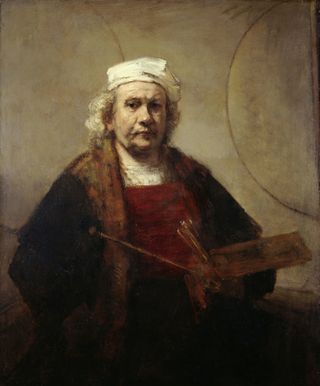
As well as the almost photographic accuracy of the proportions of Rembrandt’s self-portraits, the researchers think the artist's famed use of contrasting light and dark areas (called chiaroscuro by art historians) may also be an artifact from projections made with mirrors.
This painting, "Self-portrait with two circles," is one of Rembrandt's last, and was painted in oil on canvas between 1665 and his death in 1669.
It shows a "soft focus" effect, with strong light and strong detail around the face of the artist, but low detail and softer light towards the edges. The researchers say the same effect is seen in projections made with a flat and a curved mirror.
Sign up for the Live Science daily newsletter now
Get the world’s most fascinating discoveries delivered straight to your inbox.
Tom Metcalfe is a freelance journalist and regular Live Science contributor who is based in London in the United Kingdom. Tom writes mainly about science, space, archaeology, the Earth and the oceans. He has also written for the BBC, NBC News, National Geographic, Scientific American, Air & Space, and many others.












